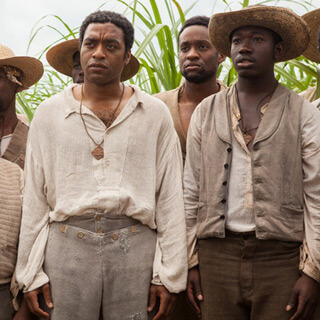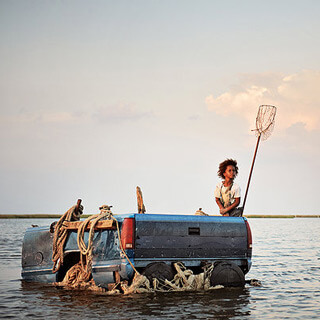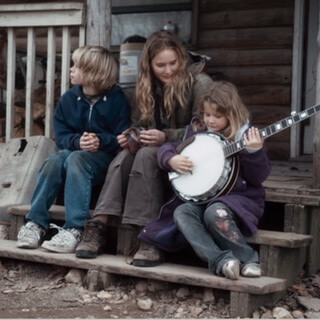Overview
In this review essay, Eric Solomon places Loving (d. Jeff Nichols) alongside Moonlight (d. Barry Jenkins) as films inviting viewers to enter the breach and break expectations of received narrative form and cultural understanding.
Beneath

Beneath the landmark 1967 Loving v. Virginia US Supreme Court case is a very simple story: two people, Richard Loving and Mildred Jeter, loved each other and wanted to marry and raise their family in rural Caroline County, Virginia. In the 2016 cinematic dramatization, Loving, writer-director Jeff Nichols best exemplifies this simplicity neither through dramatic courtroom scenes nor in his scant exploration of iterations of the legal process needed to achieve legalization of interracial marriage in the Court's decision, but in quiet moments of private intimacy.
The film neither glorifies nor sanctifies. Nichols proceeds with care, illustrating the ways in which all intimacies are negotiated and far from simple. Midway through Loving, after living for some years in exile in Washington, DC, Mildred and Richard decide, in violation of state law, to move back to Virginia with their three young children. They find a farmhouse. It has no telephone or easy connection to the outside world. As the family drives up, Mildred's face beams as she sees her new home—glistening white in the sunlight, surrounded by wide-open space. Richard smiles at her happiness. Mildred's goal is simple, as she tells Richard in DC, a city antithetical to her way of life: "I won't raise my family here." She will raise their children in the rural environs of her home state and in secrecy if need be. Yet, in this scene, as Mildred's joy radiates in the face of actress Ruth Negga as captured by cinematographer Adam Stone, Richard turns and stares into the beyond, back down the road from which they came. While Mildred is intent on raising their children in a manner she sees fit, Richard's goal, as he tells her in one of the film's most emotional scenes, is different yet equally simple: "I can take care of you." In these brief, quiet moments, Mildred is at home; Richard is afraid.
Beneath the Lovings's story, then, are bedrock truths that all couples must negotiate: intimacy and protection in the present, and care and preparation for the future. Nichols crafts this narrative through images of the marriage bed, the laying of a home's foundation, and front porches looking out to an idyllic and unknown beyond. As I search Loving for the "beneath," I recall the late Eve Kosofsky Sedgwick's claim that reading for the beneath fosters narratives of "depth or hiddenness" calling out for "a drama of exposure."1Eve Kosofsky Sedgwick, Touching Feeling: Affect, Pedagogy, Performativity (Durham, NC: Duke University Press, 2003), 8. Sedgwick's foundational contribution to the field of queer theory was her implicit understanding of the closet-structure and coming-out narrative and how they functioned. Sedgwick understood the closet as a "resilient and productive… structure of narrative" with a firm "hold on important forms of social meaning" both before and since the great gay liberationist movement "began" at Stonewall. See Eve Kosofsky Sedgwick, Epistemology of the Closet (Berkeley: University of California Press, 1990), 67. Like other key thinkers such as Michel Foucault and Judith Butler, Sedgwick understood the "very specific crisis of definition" implicit in binary distinctions like gay/straight, homosexual/heterosexual, black/white, as well as how that crisis is often socially constructed, limiting the possibilities of non-normative subjectivities (72). Such distinctions create hierarchy and the implicit desire on the part of the majority for the minority to be exposed, excavated, and/or transcended. These realities necessitate giving voice. Yet, we can read silence and invisibility as power. Arguably, in Loving and Moonlight, what is unsaid, what is invisible, is represented as equal in power to what is said and shown. Reading for the beneath raises ethical questions: Why do we need to justify the loving of this particular couple as valid? For whom are the filmmakers making Loving and why are they placing this story of the past in our present? What are the stakes of excavating and exposing the Loving story now? In supplanting readings for the "beneath," Sedgwick calls for readings of the beside, in which "a number of elements may lie alongside one another… Beside comprises a wide range of desiring, identifying, representing, repelling, paralleling, differentiating, rivaling, leaning, twisting, mimicking, withdrawing, attracting, aggressing, warping, and other relations"—such as loving or moonlighting.
I read Loving not as a film that exposes either the "Loving Story" to a wider audience or the quintessential nature of interracial loving, but as an imperative film which ask viewers to place themselves "beside" others in acts of creating, understanding, universalizing and identifying, legalizing, equalizing, and yes, loving. In so doing, I will read it alongside another 2016 film, Moonlight, to illustrate the power of both films in breaking expectations of narrative form and cultural understanding. Both films invite us to touch, to feel, the intimate lives of their characters in opposition to forces that define, prescribe, limit, and curtail.

Remember that the grand story of the Lovings—given the photojournalistic treatment by Grey Villet in Life magazine, the Lifetime television treatment with Richard Friedenberg's Mr. and Mrs. Loving (1996), the documentary treatment with Nancy Buirski's The Loving Story (2011), and now the Hollywood treatment—is only known to us, only "a drama of [continued] exposure," because Mildred first wrote a letter to the ACLU via Robert Kennedy in 1963 seeking legal assistance in moving her family from DC back home to Virginia. We know the Lovings because Mildred first engaged in a quiet, solitary act of letter writing. The Lovings were neither unique nor exemplary in their transgressive love. They were unique in their successful resistance to the laws that sought to define how and where they could love and live. And they were unique in asserting that beneath their love was something that could not be cast aside, exiled, closeted.
Beside
Beside each other, they sit in moonglow. Nichols's film opens: first shot Mildred Jeter, second Richard Loving, then both, equal visual weight. Mildred, black and Rappahannock, is pregnant; Richard, white, is the father. Crickets chirp in the background of the 1958 Virginia night. There is silence and joy. They are about to marry, to be parents; they look to the future. Despite Nichols's creative license in blurring the timeline their choice is simple: they will build a life together.
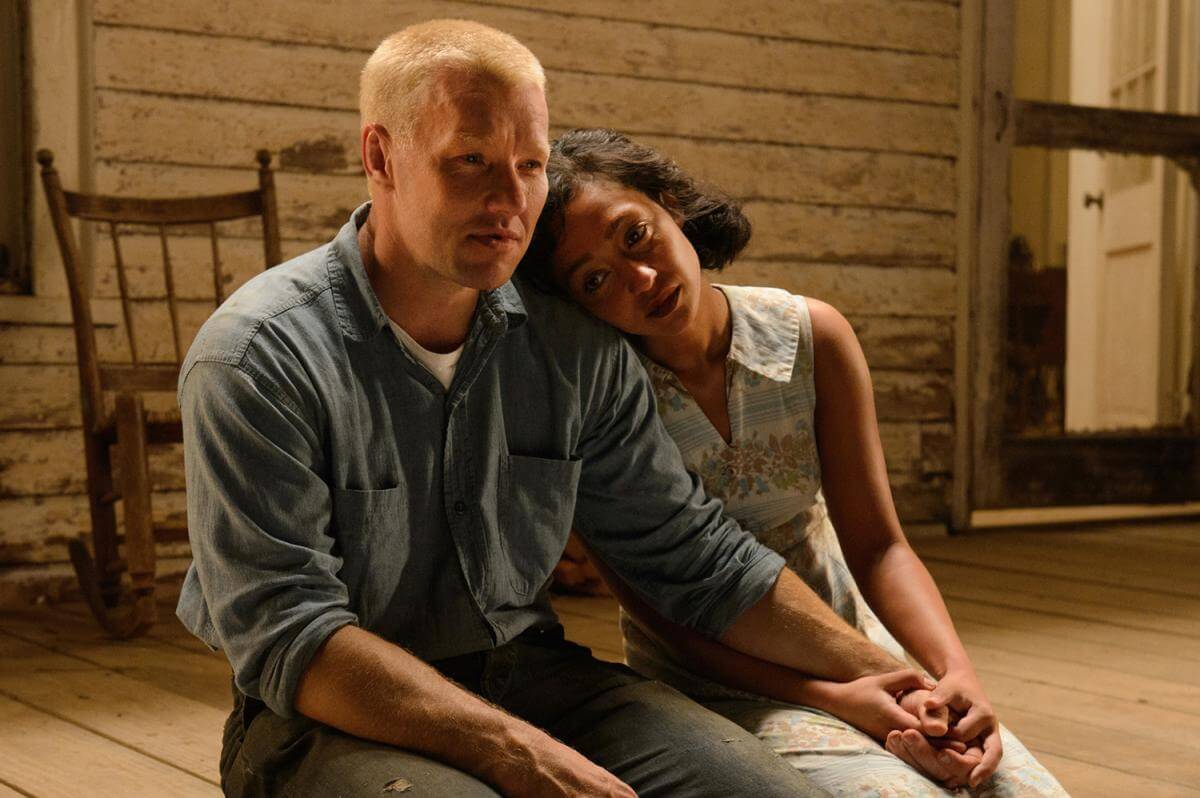
Loving challenges viewers because it is largely a meditative film telling this simple story, not a film of award-baiting fireworks or melodramatics. Nichols's goal in writing and directing was "to concentrate on the day-to-day lives of the Lovings" and "make a really slow, quiet film."2Joe Robberson, "Director Jeff Nichols talks 'Loving,' His relationship With the South & His Muse, Michael Shannon," Zimbio, November 7, 2016, http://www.zimbio.com/Zimbio+Exclusive+Interviews/articles/bqW7H-jZy09/Director+Jeff+Nichols+Talks+Loving+Relationship. The film's composition takes on equal weight to its script: not only what Loving says but also how it says it. Framing becomes central in cinematically portraying the Lovings. The camera eye presenting the narrative reveals an implicit resistance to bombastic inauthenticity. Nichols frames the Lovings via numerous shots of Richard's construction jobs—building home frames with 4x4s, laying foundations of cement blocks, insulating homes with the durable stacking of bricks and scraping of the mortar trowel—and Mildred's domestic work—washing dishes, ironing clothes, speaking on the telephone, buying groceries, running after her kids. Nichols elevates the quotidian tasks of the Lovings into profound meaning. The Lovings simply wanted to build a home together.
As a filmmaker, Nichols understands that in representing a true story that changed the US Constitution, Loving requires both adherence to the preexisting historical record and a multi-dimensional narrative framing of his central characters' lives.3Nichols, a native of Arkansas, has made four previous films: Shotgun Stories (2007), Take Shelter (2011), Mud (2012), and Midnight Special (2016). All of these films are fiction. Loving is Nichols's first film to be rooted in fact. Nichols understands the stakes and proceeds with great care. Loving presents the moments of rupture well known to historians and legal scholars: the invasion of the Lovings's bedroom, their arrest, Mildred's five-day imprisonment, the abrupt judicial decision, and their exile from their home state. Like The Loving Story (2011) documentary before it—which divided its narrative into sections entitled the Crime, Exile, the Climate, the Court, Oral Arguments—Nichols's film presents the known facts with chronological precision. Richard and Mildred committed a crime; they broke the state's love law. A legal holdover from slavery and Jim Crow, the Virginia Racial Integrity Act of 19244Virginia was not alone in enforcing such legal holdovers. By the time of the 1967 decision, fifteen other (mostly southern) states (Alabama, Arkansas, South Carolina, North Carolina, Georgia, Mississippi, West Virginia, Missouri, Louisiana, Kentucky, Florida, Texas, Tennessee, Oklahoma, and Delaware) had similar anti-miscegenation laws on the books. While the Supreme Court's federal decision invalidated all of these state laws, it would take until 1998 and 2000 for South Carolina and Alabama, respectively, to amend their state constitutional language on miscegenation. made it illegal for men and women of different races to marry and live together. Initially, the Lovings accepted a deal to live outside Virginia for twenty-five years or risk re-arrest. In exile, they moved to DC. They grew homesick and disenchanted living in a space that was not their own. Mildred contacted the ACLU, which took on their case. They secretly moved back into Virginia but were discovered and re-arrested. Their case worked its way to the US Supreme Court, and in 1967, the Lovings won. All of this is in Nichols's film, yet he never lets the grandiosity of the circumstances supplant the simplicity of story. This is not The Loving Story; it is Loving.

The stakes for present-day viewers are not whether to understand Mildred and Richard Loving's marriage as equal and legal. That question is moot. The questions today are whether we can see their loving-struggle alongside other forms of loving we still debate, and whether we can accept the lives their loving created as lives equal to all others. For us, then, the Lovings serve as precedent.
"All Love is created equal" says the film's tagline. But Loving's imperative implicitly asks: Who does all include? What is love? When is the time? What do we mean by created? How equal, by what terms? These questions call forth the positionality of various loves alongside one another in cultural understanding and legal equality.
In two of Grey Villet's Life magazine images, Richard and Mildred stand or sit beside one another at their home. Perhaps the film's most powerful image is a similar moment of intimacy in which viewers are invited to sit alongside. It is an image used in the film's promotion: Mildred sits in Richard's lap, holding his head close to her chest. They sit at a kitchen table. An embrace. Silence. Yet, they are in exile in DC; this is not their kitchen table. This still frame invites you to the table alongside them. To dare disrupt this quiet scene. Dare to deny the fierce simplicity of their loving. Help bring them home.

Beneath
Beneath Loving is bedrock: textures of mortar and soil, dirt and desire, the need to build a home and be rooted. Beneath Barry Jenkins's Moonlight is an ocean: the need to be visible as something other than the expected or prescribed, to be seen as singular and more than a drop drowning in the multitude. Loving and Moonlight, released in the same year, are period pieces illustrating tensions between fixity and fluidity in journeys we must take to love ourselves so that we can engage in acts of loving others.

Beneath Moonlight is not the often-told, true-life story of the Lovings, but autobiographical traces of playwright Tarell Alvin McCraney and writer-director Barry Jenkins's upbringings in 1980s Miami.5Moze Halperin, "Playwright Tarell Alvin McCraney Discusses the Piece that Inspired 'Moonlight,'" Flavorwire, October 21, 2016, http://flavorwire.com/592191/playwright-tarell-alvin-mccraney-discusses-the-piece-that-inspired-moonlight. Halperin writes, with "In the Moonlight, which McCraney set in his own home of Liberty City, Florida, the playwright tried to lay out some of his own biographical questions about growing up with a mother grappling with drug addiction, and growing up gay in a neighborhood sequestered by race and class, in a community where his own divergence from masculine norms led him to be classified as Other from a young age. Moonlight writer/director Barry Jenkins likewise grew up in Liberty City—and in the very same public housing unit as McCraney—Liberty Square, though they didn't know each other. His adaptation of McCraney's work combined their diverging and overlapping experiences, and projected them onto the story of a protagonist, who, through the convergence of time and society's all-too-often blanketing perceptions of black manhood, lives as a beautifully unchanging soul housed within three metamorphosed bodies." Moonlight, adapted from both McCraney's sketch In Moonlight Black Boys Look Blue and from life, is fiction. While the film's tagline may read, "This is the story of a lifetime," it is not the story of any one lifetime but a composite of the experiences of many young black "gay" men in the urban South. It burrows beneath while seeking to get beyond. It is not "based on a true story" in any distinct way but culled from the archives of the many men like protagonist Chiron who do not get represented on screen. Moonlight is simple and grand, specific and universal, drop and ocean. The most apt preposition for an exploration of Moonlight may not be "beneath" but "beyond." Moonlight asks to go beyond what we think we know about men, about being black, about being gay. It asks us to think beyond any singular identity and consider the intersections where black-gay-men struggle to exist in places such as Miami and Atlanta.
Jenkins structures Moonlight in a tripartite way, beginning with "Little" and ending with "Black," both nicknames for the character's actual name, "Chiron," the title for the middle section. Little-Chiron-Black. This structure invites side-by-side analysis around three moments of time in one man's life. Little-Chiron-Black function as islands of existence and snapshots of time representing the fragmentary nature of a man growing into himself and negotiating racial, gender, and sexual identities. Viewers encounter all three—Little-Chiron-Black/ Black-Gay-Man—distinctly but also connected across the intersectional, hyphenated breach.
Beyond
Beyond visible: the sound of ocean waves crashing before the fade-in is how Moonlight begins—with what cannot be seen or known but only heard and approached. Loving begins in fixity and stillness—crickets chirping in a calm, rural Virginia night. Moonlight begins in fluidity and chaos. We hear the non-diegetic crashing of waves and the diegetic "Every Nigger is a Star" playing on Juan's car radio as we fade-in to his meeting one of his drug-dealing employees. The camera spins like the eye of a hurricane or a whirlpool undercurrent, circling and weaving around the actors as director Barry Jenkins introduces 1980s Miami and the slow-drain effect of drug addiction and trafficking. We fall into Loving, into the front porch simplicity of a couple, a grand narrative before them. With Moonlight, we crash full force into a street life where "Every Nigger is [or aims to be] a Star."
So much of Moonlight is disassociation, disembodiment, and disorientation: sounds of waves, cracked glass underfoot, muffled moans, zippers descending, voices and whispers, continued movement, and abrupt shifts. The main character Little-Chiron-Black is never fixed, but constantly shifting and adapting. Each section in this man's life is built around a core set of characters who shape him and ultimately help him associate, embody, and orient so that we come to "know" this man not by virtue of his fixed being but by his continual becoming.
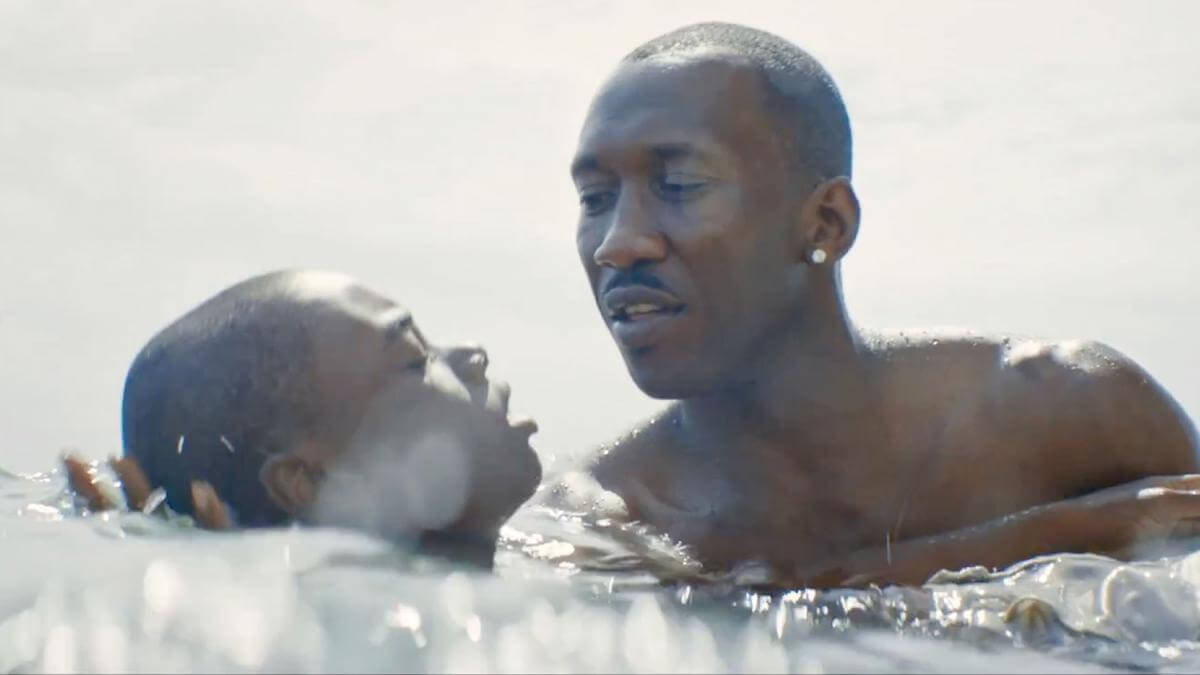
"Little" is structured around Juan, the first character we meet in Moonlight, stepping out of his bright blue car. As played by Mahershala Ali, Juan is not one-dimensional, neither villain nor hero. Yes, he deals drugs, but he also serves as mentor and caretaker for "Little," a lost boy whose mother is adrift on the crack-cocaine Juan sells. It is Juan who teaches Little to swim, who stares out across the Atlantic—back home—and tells Little that he was once called "Blue" as a boy in Cuba, but he no longer identifies with that name because "at some point you got to decide for yourself who you gonna be." Juan creates his morally ambiguous self, and it is from Juan that Little learns self-becoming.
As "Little" progresses, viewers come to know Little's sexuality even before he understands it. In the closing scene of this first snapshot in Chiron's life, Little asks Juan and his partner Teresa, who serves as a second mother, "What's a faggot?" The couple exchange knowing glances, and refuse to lie. They tell him that he will know if he's gay when he knows.
If "Little" reveals Chiron's first moment of self-awareness and recognition, "Chiron" is Little's adolescent hardening. "Chiron" centralizes Kevin, Little's childhood friend and first pubescent crush. "Chiron" shows a young man who lives in fantasies: wet dreams in which the sounds of waves and grunting lead him to find Kevin fucking a faceless woman beneath the south Florida palms. "Chiron," second snapshot in this story of a lifetime, is full of similar sex and frustration, daydream and risk, role-playing and reality.

"Chiron" begins with a science teacher discussing DNA in class, suggestive of the heteronormative idea of sex as procreation as well as the heightened sexual risk associated with certain methods of swapping DNA. As if to reify these passing suggestions, Jenkins returns the viewer, in the middle of the "Chiron" section of the film, to the same class, alongside the students, as the same teacher mentions a "lack of white blood cells" in his lesson plan. Said in passing, "a lack of white blood cells" serves as a potent phrase in the middle of a movie set in the early, death-sentencing years of the HIV/AIDS epidemic in which gay sexuality and IV-drug behaviors were stigmatized, misunderstood, and pathologized. It is also a reminder of the startling disparity that people of color and drug addicts continue to face, measured in new HIV infection rates, access to care, and number of AIDS-related deaths in the United States.6"Lifetime Risk of HIV Diagnosis," CDC, February 23, 2016, https://www.cdc.gov/nchhstp/newsroom/2016/croi-press-release-risk.html; "CDC Fact Sheet: Today's HIV/AIDS Epidemic," August 2016, https://www.cdc.gov/nchhstp/newsroom/docs/factsheets/todaysepidemic-508.pdf; Claire Galofaro, "Appalachia Bracing for HIV," U.S. News & World Report, June 5, 2015, http://www.usnews.com/news/us/articles/2015/06/04/appalachia-gripped-by-hepatitis-c-epidemic-bracing-for-hiv. Is it any wonder that Chiron, a young man trying to decide who he is going to be, might be frightened of the sexual urges he feels for Kevin, of both the tenderness and hardening that he is told make him sick, soft, not "man" enough?
And yet, always beneath the surface of Chiron's confusion and self-discovery is Kevin, a young man who boasts of his sexual conquests and the size of his genitalia, who seems to better negotiate his sexual fluidity against the unforgiving, tough, adolescent, environment. Kevin is a consummate performer, adapting his personality and behavior to survive the only world he knows. Kevin recalls James Baldwin's confusion over the term "gay": "I didn't understand the necessity of all the role playing."7Richard Goldstein, "'Go the Way Your Blood Beats': An Interview with James Baldwin," In James Baldwin: The Last Interview and Other Conversations (Brooklyn, NY: Melville House, 2014), 59. To be "gay," to own that identity especially at a certain point in time, one had to consistently play some version of a part—clone, closet case, down low, top, bottom, vers, masc, macho, fem, maricón, queen—in order to survive. One could not simply be "out"; one had to negotiate how one was out. Moonlight never explicitly labels or categorizes either Kevin or Chiron's sexuality; they just are. In the street life of 1980s urban black America, being out in whatever degree meant playing some part to reveal or conceal, make or mask. If one did not play a part, all that was left was a form of self-denial so internally violent, repressing, and damning that lashing out externally seemed a likely result.
It is Kevin who first nicknames Chiron "Black," giving him the role of a lifetime. Kevin knows playing a part is survival. He understands risk and danger associated with authenticity. Chiron does not understand the necessity of role-play or the inundation of danger he receives at school, in the streets, and at home. All Chiron understands are his urges, his emotions, and his desire to act upon them. Throughout most of "Chiron," he rejects Kevin calling him "Black." He is not yet ready to play the part.

All this changes after Kevin and Chiron meet on a beach, sitting side-by-side as they stare out into the ocean. Kevin is tough, his façade intact. Chiron tells him, "I cry so much sometimes I feel like I just turn to drops." Chiron is "soft," drowning in his own emotions. When Kevin comforts him, the two kiss. The only sexual act they engage in is the one of least risk: Kevin masturbates Chiron. As Kevin wipes Chiron's DNA in the sand, he marks this space, at the edge of the sea, as one of new life where each can stop playing a role and see each other clearly. It is a space of safety not unlike the calm front porch of Loving. They sit side-by-side, and the roles the world asks them to play fall away.
Such safety is illusory. The roles return in full force. Kevin must act a man and beat Chiron after the school bully pressures him to do so. During this first fight scene, as Kevin punches Chiron repeatedly, the camera again moves in chaotic circles, Jenkins illustrating the whirlpool undercurrent, the violent drain, of toxic masculinity. Days later, Chiron responds with a violent rage, beating the class bully who made Kevin prove his manhood in beating Chiron, the soft "faggot." Chiron becomes "Black." Even after Chiron's retaliation in which he plays the role of tough man, the counselor calls him a "boy." In hardening himself to be tough, to be "Black" in order to survive, Chiron is as lost as ever.
The "Black" section of the film begins in Atlanta where Chiron and his mother, Paula, have moved. Black is all muscle, physically imposing, leading a solitary life back on the streets. His mother has sobered up, choosing to live at the rehabilitation center. Yet, it is not Paula who haunts "Black," it is Juan. While mentor to Little, Juan also served as a dangerous model in propagating street life, drug-work, and moral ambiguity as a tough but necessary way of life for a black man. He may teach Little not to fold into himself, but he also provides Little a caricature to play. With "Black," we see a man adopting the teeth, headwear, car and dash ornament, and street lifestyle of his mentor. Yet, Black feels like a radical and a false departure—physically, emotionally—from both Little and Chiron. As the ghost of Juan hovers over "Black," Kevin suddenly resurfaces to offer a moment of startling grace, helping Chiron unmask and reveal "Black" to himself. With "Black," Chiron must learn to integrate the disparate influences of Juan and Kevin into some version of himself.
Little-Chiron is not Black, and it is Kevin who can perhaps best expose and save him from this false self. When Black drives down to Miami and shows up at Kevin's diner, Kevin cooks him dinner and plays "Hello Stranger" on the jukebox. Yes, they are strangers because time and place have divided them. But the meaning goes deeper: Black has taken on the role of stranger to himself; we hear the sound of ocean waves return. Kevin asks Black: "Who is you?"

Moonlight begins in darkness, with the sound of ocean water—currents, rhythms, and waves—before fading in to the narrative. It ends with two men, in a kitchen, pouring a glass of water, negotiating each other's past and the present they long to enact. It ends with two men bathing each other in a warm embrace. When Black tells Kevin, "no man has touched me since you," we come to understand Black's answer to Kevin's question. "Who is you?" I am yours, Black seems to say. As Kevin holds Black, we come to "know" and see the man Chiron apart from the roles he has played. The irony of Chiron's story of a lifetime is that it is no longer a "story" with characters—"Little," "Chiron," "Black"; black-gay-man—to create or perform. Illustrating Little-Chiron-Black's harnessing of the ocean's immense body of water into a single glass—his pulling in of desire and intersectional identity from the vast, diffuse, and invisible to the known, contained, and experienced—is the achievement of Barry Jenkins's film.
In colloquial terms, to moonlight is to pretend to be something you are not; moonlighting is role-playing. In the film's final frames, we see Little again, his back to us, staring out at the immense waters of the Atlantic. To paraphrase Kate Chopin, the voice of the sea is clam, it is sensuous. It invites you to wade into its waters and lose yourself in the invisible beyond.8Kate Chopin, The Awakening (Chicago and New York: Herbert S. Stone & Co, 1899). At Moonlight's end, however, Little-Chiron-Black is awakened. In the final frame, Little does not walk into the waters, lost to us forever. He turns to the camera and stares directly and fiercely into its lens. He breaks the fourth wall, shattering the pretense of performance. He is present and visible. He is blue in the moonlight. He dares us not to see him and join him on this beach. The film fades to black.

Beside, the Breach
Searching for you in the hollow cage…
—Richie Hoffman, "Sea Interlude: Moonlight"9Richie Hoffman, "Sea Interlude: Moonlight," The Missouri Review, 34, no. 4 (2011): 93.
Beside ocean water, as waves break on the shore, Moonlight ends with a return to Little standing on a solitary beach. Awakened, he stands at the shore of a new becoming, no longer seeking to get beyond himself but to be within himself. The whirlpools have stilled. He stands calmly. As viewers, we are asked to look him in the eye, see him, to place ourselves alongside him. Actor Mahershala Ali, in accepting the SAG award for his performance as Juan, described Chiron as a persecuted man who was folding into himself. Our responsibility, Ali suggests, is to uplift him and tell him he matters. He invites us all to "do a better job of that."10Alex Abad-Santos, "Watch: Mahershala Ali's powerful SAG Awards speech on persecution and acceptance," Vox.com, January 29, 2017, http://www.vox.com/2017/1/29/14433536/mahershala-ali-2017-sag-award-speech-video. Journeys of empathy are not always easy, but as Baldwin once said, you cannot change what you will not face. As we face Little, we stand alongside. We enter his breach as we hear the rhythm of breaking waves. We do not look toward the horizon for a better beyond.
When McCraney, on whose work Moonlight is based, approached writing a play about Hurricane Katrina's devastating effects on New Orleans, he and his collaborators settled on the title The Breach. It begins, "It was water that woke us up that morning."11Catherine Filloux, Tarell Alvin McCraney, and Joe Sutton, The Breach. In Katrina on Stage: Five Plays, edited by Suzanne M. Trauth and Lisa S. Brenner (Evanston, Illinois: Northwestern University Press, 2011), 57.
Beneath Moonlight, the slow return of water and its rhythms upon the shore—fluidity constantly reshaping fixity—wake Chiron up to his true self. Like water splashed in the face of the deep-sleeper, the element of water snaps Chiron out of the fragmentary and traumatic breaches that seek to define him. At Moonlight's close, we join Little-Chiron-Black as he ceases folding into himself and begins to become whole.
In this review essay, I have framed my story deliberately, placing Loving and Moonlight beside each other, linked in more ways than the year of their release. Both films depict breaches—Loving's depiction of a breach of law, Moonlight's breach of time via its non-continual structure and motif of the sound of waves breaching on the shore. More important are the symbolic breaches each film forces us to ponder. Loving is a calm illustration of the fierce power of the action of breaking laws in order to live and love: what is loving? How do we love? Moonlight is a chaotic rumination on being broken, fragmented, traumatized, and the slow process of recovery. What is moonlighting? How do we all moonlight? Each film emplaces viewers alongside characters in the breach. Sutured into the narrative of Loving's calmness and Moonlight's chaos, we wade in these waters in which each lifetime has a story and all love is equal.

It is perhaps no accident that both Loving and Moonlight, which ponder never-simple questions of race and sexuality, take place in US southern spaces, spaces historically rife with such interrogations. It is also no accident that neither features stereotypical tropes of "southern" filmic narratives. Yes, Loving largely takes place in Virginia, and yes, there is the racist Sheriff and the biased state courts, but the "big white house" is not a centralized plantation but an isolated loving home. In one of the film's most haunting moments, we see a rope being tossed over a tree branch—evoking a murderous history. Nichols, however, immediately cuts to the Loving children who are using this rope for a tire-swing. In rural Virginia, poor whites and blacks often exist alongside one another instead of in opposition. Additionally, the subtext of race in Loving is not simply black and white. The film implicitly asks how can you tell someone with Native blood—whose very marriage license lists her as "Indian"12Arica L. Coleman, "What's Fact and Fiction in Jeff Nichols's Film about the Lovings," History News Network, November 14, 2016, historynewsnetwork.org/article/164415.—that she cannot live in this space?
Similarly, Moonlight takes place in south Florida and Atlanta, but the space is far from traditionally confined. Moonlight exists as spatially liminal: a film located somewhere along the US South—Circum-Caribbean—Black Atlantic continuum. Both Juan and Kevin, the two most important male figures in Chiron's journey, have roots elsewhere. Jenkins's use of the motif of water breaching signifies the larger perplexity of "rootedness" and fixity for all African Americans with ancestors forcibly brought to American shores. How can anyone find stasis out of a heritage of migration, movement, fluidity, and the breach that was the Middle Passage?

The power of Loving and Moonlight lies in their ability not to didactically excavate beneath or idealistically get beyond, but to emplace the viewers beside the characters within the breach. For Mildred and Richard Loving, that breach is the uprooting of home and the exile they endured. For Little-Chiron-Black, that breach is the brokenness of waves crashing into and continually shaping him to be someone other than who he knows and wants himself to be. Can we cross the empathetic breach to see ourselves shaped by deferred dreams and broken promises? Can we see ourselves, as Black comes to see himself, as a hollow shell moonlighting as a full self? Can we understand his awakening?
Both films implore moments of grace—where we sit alongside on a porch, fight alongside for fair and equal justice, hold one another when we are broken, see and witness the truth and significance of each other's lives. We enter the breach when we rupture our own understandings and prescribed identities.
Loving and Moonlight are linked still in more direct ways. Near the end of her life, Mildred Loving wrote in support of Massachusetts's legalization of same-sex marriage and to commemorate the fortieth anniversary of Loving v. Virginia: "I believe all Americans, no matter their race, no matter their sex, no matter their sexual orientation, should have that same freedom to marry… I support the freedom to marry for all. That's what Loving, and loving are all about."13"Loving for All," Statement by Mildred Loving, June 12, 2007. In Grey Villet, Loving: An Intimate Portrait (New York: Princeton Architectural Press, 2017), 111.
The real-life examples of the Lovings and Loving helps us realize the stakes. Moonlight and Little-Chiron-Black help us understand the slippery nature of ethical imperatives to make lives and loves matter. How do we understand forms of loving—coexisting, cohabitating, desiring, fornicating, fucking, and polyamory, to name but a few—outside the moralizing imperative to move beyond individual bodies and pleasures to the more official, legal institution of marriage? The literal "beyond" of Loving v. Virginia is the Supreme Court's 2015 Obergefell v. Hodges decision that legalized same-sex marriage.14Loving v. Virginia was cited as legal precedent for the Supreme Court's Obergefell v. Hodges decision in which the court saw "the history of marriage is one of continuity and change." See https://www.supremecourt.gov/opinions/14pdf/14-556_3204.pdf. Yet, the achievements of legal recognition of interracial and same-sex marriage, nearly fifty years apart, do not answer the question: how is marriage a moonlighting form of loving and an impoverished form of codifying our love alongside other loves?15Lynne Huffer, "The New Normal is Not Good Enough," The Huffington Post, February 2, 2016, http://www.huffingtonpost.com/lynne-huffer/the-new-normal-not-good-enough_b_1895309.html. How is marriage legalization an easy and impermanent solution to the ethical imperative to see other forms of love alongside one's own?
As Loving and Moonlight bravely enter our world, we ponder the questions they raise as new dangers emerge. The election of Donald Trump feels like an unnavigable breach for many of us, but as the saying goes, now is the time for artists to go to work. In 2015, Toni Morrison wrote of her response to Bush's 2004 re-election: "This is precisely the time when artists go to work. There is no time for despair, no place for self-pity, no need for silence, no room for fear. We speak, we write, we do language. That is how civilizations heal."16Toni Morrison, "No Place for Self-Pity, No Room for Fear," The Nation, March 23, 2015, https://www.thenation.com/article/no-place-self-pity-no-room-fear. Chauncey Devaga cites both Loving and Moonlight as "symbolic resistance in the age of Trump…. They offer a powerful counternarrative to the reactionary social and political forces that elected Donald Trump."17Chauncey Devega, "'Moonlight' and 'Loving': Film as symbolic resistance in the age of Trump," Salon, December 10, 2016, http://www.salon.com/2016/12/10/moonlight-and-loving-film-as-symbolic-resistance-in-the-age-of-trump/. Perhaps what both Moonlight and Loving reveal is that the most important part of speech in our country is the progressive tense "ing"—working, doing, creating, healing. We engage in acts of forming and becoming a more perfect union, whether that union is the result of a crossed breach of difference or sameness. No more moonlighting, no more pretending, we all benefit from loving. We the people must be our own becoming. 
About the Author
Eric Solomon is a doctoral candidate in the department of English at Emory University. His dissertation project, Southernmost Currents: Liminal Narratives of Love in the Florida Straits, reads south Florida as a zone of confluence for various queer figures in the latter half of the twentieth century.
Cover Image Attribution:
Stills from Loving (2016) and Moonlight (2016). © Focus Features and A24.Recommended Resources
Text
Coleman, Arica L. That the Blood Stay Pure: African Americans, Native Americans, and the Predicament of Race and Identity in Virginia. Bloomington: Indiana University Press, 2013.
Filloux, Catherine, Tarell Alvin McCraney, and Joe Sutton, The Breach. In Katrina on Stage: Five Plays, edited by Suzanne M. Trauth and Lisa S. Brenner, 53–116. Evanston, Illinois: Northwestern University Press, 2011.
Johnson, E. Patrick and Mae G. Henderson, editors. Black Queer Studies: A Critical Anthology. Durham, NC: Duke University Press, 2005.
Newbeck, Phyl. Virginia Hasn't Always Been for Lovers: Interracial Marriage Bans and the Case of Richard and Mildred Loving. Carbondale, IL: Southern Illinois University Press, 2004.
Powell, Patricia Hruby. Loving vs. Virginia: A Documentary Novel of the Landmark Civil Rights Case. San Francisco, CA: Chronicle Books, 2017.
Villet, Grey and Barbara Villet. The Lovings: An Intimate Portrait. New York: Princeton Architectural Press, 2017.
Wallenstein, Peter. Tell the Court I Love My Wife: Race, Marriage, and Law—An American History. New York: St. Martin's Press, 2002.
Web
Allen, Dan. "Tarell Alvin McCraney: The Man Who Lived 'Moonlight.'" NBC News. October 20, 2016. http://www.nbcnews.com/feature/nbc-out/tarell-alvin-mccraney-man-who-lived-moonlight-n670296.
Devega, Chauncey. "'Moonlight' and 'Loving': Film as symbolic resistance in the age of Trump." Salon. December 10, 2016. http://www.salon.com/2016/12/10/moonlight-and-loving-film-as-symbolic-resistance-in-the-age-of-trump.
Halperin, Moze. "Playwright Tarell Alvin McCraney Discusses the Piece that Inspired 'Moonlight.'" Flavorwire. October 21, 2016. http://flavorwire.com/592191/playwright-tarell-alvin-mccraney-discusses-the-piece-that-inspired-moonlight.
Pinckney, Darryl. "Moon Over Miami." The New York Review of Books. April 20, 2017. http://www.nybooks.com/articles/2017/04/20/moon-over-miami.
Rothman, Lily and Liz Ronk. "LIFE Magazine and Loving: The Photos that Captured a History-Making Couple." Time. November 3, 2016. http://time.com/4533385/life-magazine-loving-grey-villet.
Villet, Barbara. "The Heart of the Matter: Love." New York Times Lens Blog. January 18, 2012. https://lens.blogs.nytimes.com/2012/01/18/the-heart-of-the-matter-love.
"What is Loving Day?" Loving Day. 2012. http://www.lovingday.org/what-is-loving-day.
Similar Publications
| 1. | Eve Kosofsky Sedgwick, Touching Feeling: Affect, Pedagogy, Performativity (Durham, NC: Duke University Press, 2003), 8. Sedgwick's foundational contribution to the field of queer theory was her implicit understanding of the closet-structure and coming-out narrative and how they functioned. Sedgwick understood the closet as a "resilient and productive… structure of narrative" with a firm "hold on important forms of social meaning" both before and since the great gay liberationist movement "began" at Stonewall. See Eve Kosofsky Sedgwick, Epistemology of the Closet (Berkeley: University of California Press, 1990), 67. Like other key thinkers such as Michel Foucault and Judith Butler, Sedgwick understood the "very specific crisis of definition" implicit in binary distinctions like gay/straight, homosexual/heterosexual, black/white, as well as how that crisis is often socially constructed, limiting the possibilities of non-normative subjectivities (72). Such distinctions create hierarchy and the implicit desire on the part of the majority for the minority to be exposed, excavated, and/or transcended. These realities necessitate giving voice. Yet, we can read silence and invisibility as power. Arguably, in Loving and Moonlight, what is unsaid, what is invisible, is represented as equal in power to what is said and shown. |
|---|---|
| 2. | Joe Robberson, "Director Jeff Nichols talks 'Loving,' His relationship With the South & His Muse, Michael Shannon," Zimbio, November 7, 2016, http://www.zimbio.com/Zimbio+Exclusive+Interviews/articles/bqW7H-jZy09/Director+Jeff+Nichols+Talks+Loving+Relationship. |
| 3. | Nichols, a native of Arkansas, has made four previous films: Shotgun Stories (2007), Take Shelter (2011), Mud (2012), and Midnight Special (2016). All of these films are fiction. Loving is Nichols's first film to be rooted in fact. |
| 4. | Virginia was not alone in enforcing such legal holdovers. By the time of the 1967 decision, fifteen other (mostly southern) states (Alabama, Arkansas, South Carolina, North Carolina, Georgia, Mississippi, West Virginia, Missouri, Louisiana, Kentucky, Florida, Texas, Tennessee, Oklahoma, and Delaware) had similar anti-miscegenation laws on the books. While the Supreme Court's federal decision invalidated all of these state laws, it would take until 1998 and 2000 for South Carolina and Alabama, respectively, to amend their state constitutional language on miscegenation. |
| 5. | Moze Halperin, "Playwright Tarell Alvin McCraney Discusses the Piece that Inspired 'Moonlight,'" Flavorwire, October 21, 2016, http://flavorwire.com/592191/playwright-tarell-alvin-mccraney-discusses-the-piece-that-inspired-moonlight. Halperin writes, with "In the Moonlight, which McCraney set in his own home of Liberty City, Florida, the playwright tried to lay out some of his own biographical questions about growing up with a mother grappling with drug addiction, and growing up gay in a neighborhood sequestered by race and class, in a community where his own divergence from masculine norms led him to be classified as Other from a young age. Moonlight writer/director Barry Jenkins likewise grew up in Liberty City—and in the very same public housing unit as McCraney—Liberty Square, though they didn't know each other. His adaptation of McCraney's work combined their diverging and overlapping experiences, and projected them onto the story of a protagonist, who, through the convergence of time and society's all-too-often blanketing perceptions of black manhood, lives as a beautifully unchanging soul housed within three metamorphosed bodies." |
| 6. | "Lifetime Risk of HIV Diagnosis," CDC, February 23, 2016, https://www.cdc.gov/nchhstp/newsroom/2016/croi-press-release-risk.html; "CDC Fact Sheet: Today's HIV/AIDS Epidemic," August 2016, https://www.cdc.gov/nchhstp/newsroom/docs/factsheets/todaysepidemic-508.pdf; Claire Galofaro, "Appalachia Bracing for HIV," U.S. News & World Report, June 5, 2015, http://www.usnews.com/news/us/articles/2015/06/04/appalachia-gripped-by-hepatitis-c-epidemic-bracing-for-hiv. |
| 7. | Richard Goldstein, "'Go the Way Your Blood Beats': An Interview with James Baldwin," In James Baldwin: The Last Interview and Other Conversations (Brooklyn, NY: Melville House, 2014), 59. |
| 8. | Kate Chopin, The Awakening (Chicago and New York: Herbert S. Stone & Co, 1899). |
| 9. | Richie Hoffman, "Sea Interlude: Moonlight," The Missouri Review, 34, no. 4 (2011): 93. |
| 10. | Alex Abad-Santos, "Watch: Mahershala Ali's powerful SAG Awards speech on persecution and acceptance," Vox.com, January 29, 2017, http://www.vox.com/2017/1/29/14433536/mahershala-ali-2017-sag-award-speech-video. |
| 11. | Catherine Filloux, Tarell Alvin McCraney, and Joe Sutton, The Breach. In Katrina on Stage: Five Plays, edited by Suzanne M. Trauth and Lisa S. Brenner (Evanston, Illinois: Northwestern University Press, 2011), 57. |
| 12. | Arica L. Coleman, "What's Fact and Fiction in Jeff Nichols's Film about the Lovings," History News Network, November 14, 2016, historynewsnetwork.org/article/164415. |
| 13. | "Loving for All," Statement by Mildred Loving, June 12, 2007. In Grey Villet, Loving: An Intimate Portrait (New York: Princeton Architectural Press, 2017), 111. |
| 14. | Loving v. Virginia was cited as legal precedent for the Supreme Court's Obergefell v. Hodges decision in which the court saw "the history of marriage is one of continuity and change." See https://www.supremecourt.gov/opinions/14pdf/14-556_3204.pdf. |
| 15. | Lynne Huffer, "The New Normal is Not Good Enough," The Huffington Post, February 2, 2016, http://www.huffingtonpost.com/lynne-huffer/the-new-normal-not-good-enough_b_1895309.html. |
| 16. | Toni Morrison, "No Place for Self-Pity, No Room for Fear," The Nation, March 23, 2015, https://www.thenation.com/article/no-place-self-pity-no-room-fear. |
| 17. | Chauncey Devega, "'Moonlight' and 'Loving': Film as symbolic resistance in the age of Trump," Salon, December 10, 2016, http://www.salon.com/2016/12/10/moonlight-and-loving-film-as-symbolic-resistance-in-the-age-of-trump/. |




